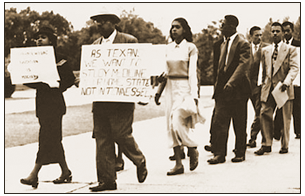|
Blockades, tree-sitting, boycotts, sit-ins, not paying your taxes, and deliberately disobeying a specific law perceived to be unjust--these are some of the many ways citizens use non-violent civil disobedience to promote political change. Very often these tactics are illegal, putting the individuals carrying out these actions at personal risk of arrest, fines, jail, and even civil damage awards.
Sometimes the act is intended to inflict losses on a specific target (usually this is the goal of a boycott). Sometimes it is intended to prevent some action on the part of others (blockades, tree-sitting) or merely to call attention to an issue (as with sit-ins).
| Techniques |
Outcomes |
Protest
Non-cooperation
Intervention |
Conversion
Accommodation
Non-violent coercion |
| Non-violent political action is usually prompted by opposition to existing laws or practices. But those who undertake such actions often propose alternative visions. Generally, non-violent action takes three forms: protest, non-cooperation, and intervention.1 |
In turn, non-violent action might produce one of three broad types of success.2 The first is conversion--your opponents change their minds and adopt your view. The second is accommodation. While your opponents maintain their views and/or their power to resist you, they nevertheless make some concessions to your demands. The third is non-violent coercion; your opponents make no changes in views or practices, but they lose the power to impose their preferences.
Civil disobedience and non-violent action are difficult tactics for citizen-based groups to undertake. While non-violent actions like boycotts are quite legal, many other actions involve actually breaking the law. In such circumstances it is very easy to be portrayed as merely disruptive or even criminal, with no respect for the law or the peace of the community. Also, such actions are often portrayed as just not constructive by opponents. And as many activists have found, the embrace of non-violence does not guarantee a non-violent response--a risk that must be factored in by any group considering these tactics.
Also, when breaking the law one risks considerable personal stress and expense. When a group of University of Texas at Austin students occupied the university president's office in the late 1980s, they were arrested, arraigned and convicted of trespassing and destruction of property. This resulted in suspensions from the university, fines and, for a few, jail time.
The practice of civil disobedience is most commonly associated with the civil rights movement in the United States in the 1950s and 1960s, in which thousands of activists engaged in civil disobedience and other protest tactics as part of the fight for equal rights for African Americans. Many Texans were involved in protests ranging from marches for integration at UT to sit-ins in cities as diverse as San Antonio and Marshall. Even as the civil rights movement becomes more distant in time, the moral mantle of non-violent civil disobedience remains, and political groups continue to consider it a critical, if often risky, political resource. |
 |
| "As Texans, we want to study medicine in our home state, not in Tennessee."3 |
 |
|
